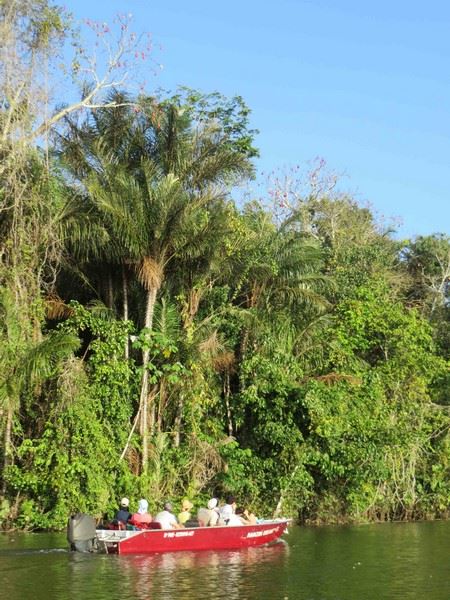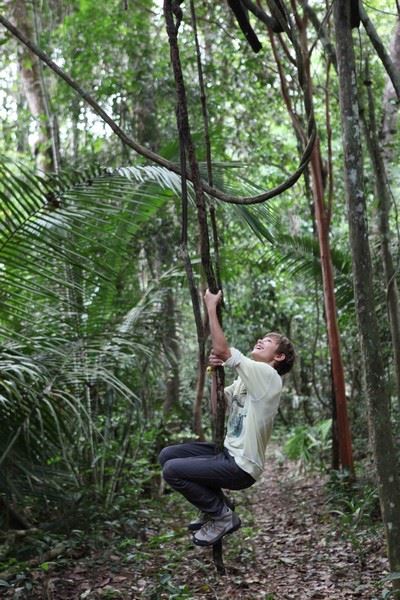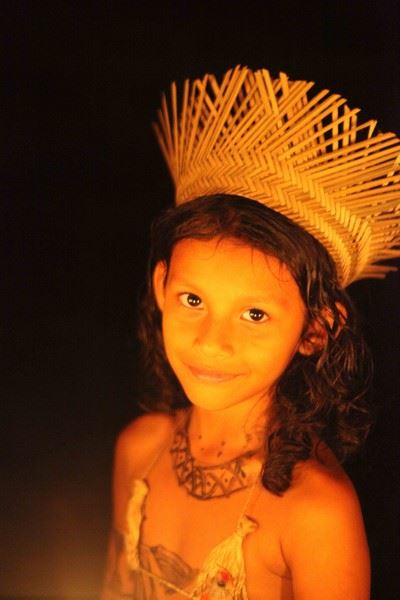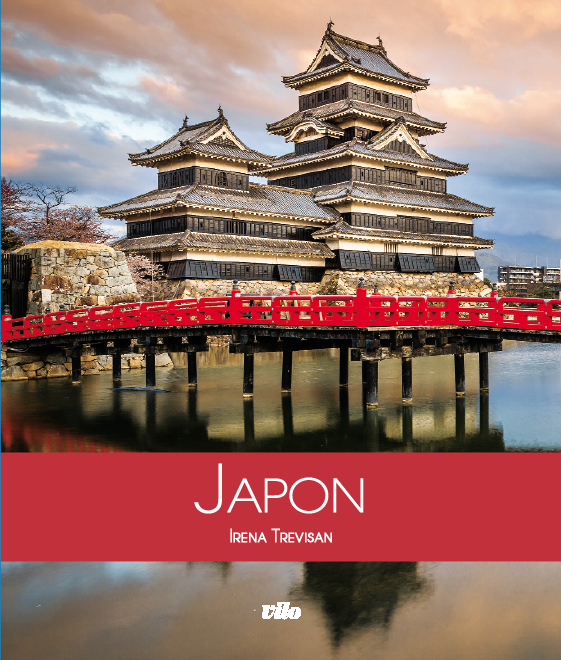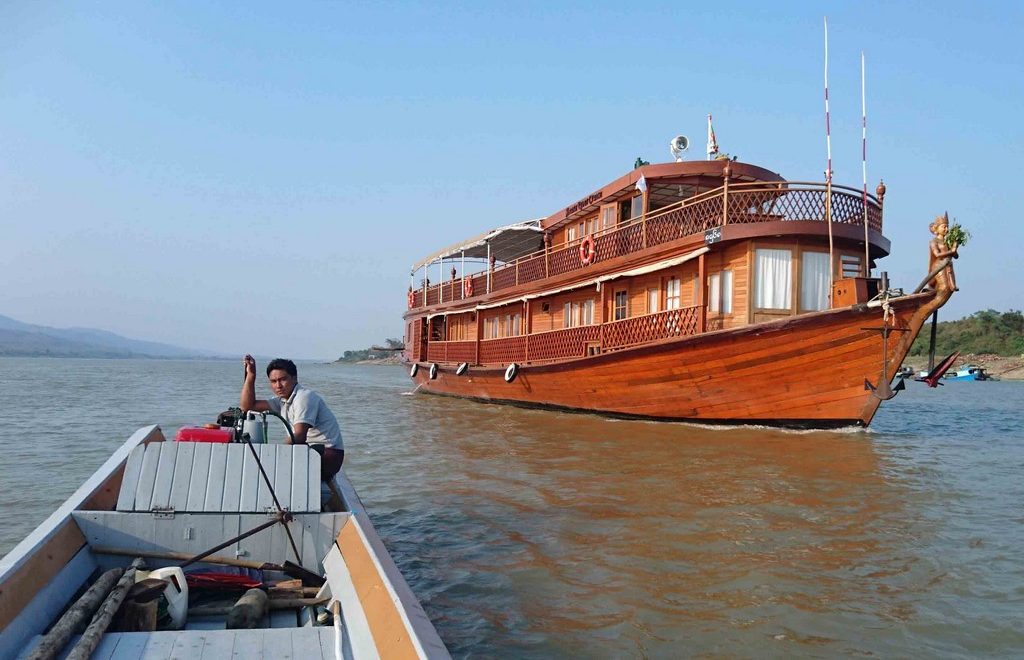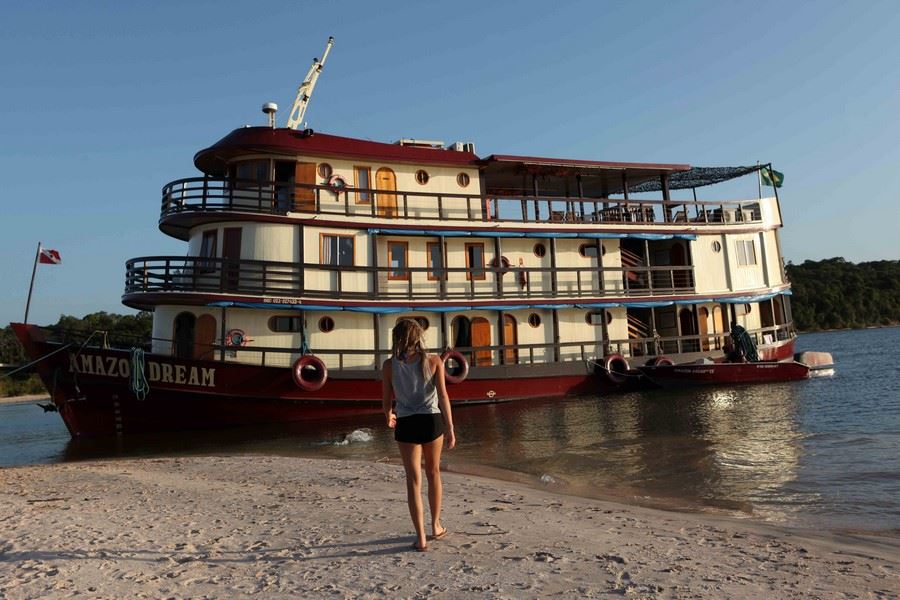
There is a land where immense skies are reflected. A land where water draws harmonious labyrinths, where getting lost is an unforgettable adventure, where forest, rivers and lakes are inextricably intertwined. We are in the heart of Amazonia, for an exceptional cruise through primary rainforest and floodplains.
Santarem, home port of the Amazon Dream
Our cruise on the world's longest river, the Amazon, and one of its tributaries, the Tapajos, begins in Santarem, the second largest city in the state of Para. The boat has the look of the old coasters that ply the river. Built from rot-proof ipe and itauba wood, it's one of the most comfortable vessels on which to explore the world's last great rainforest and its mythical river. We are 18 passengers who will be discovering this biodiversity sanctuary, dating back more than 15 million years, in optimal conditions of welcome, service and comfort.
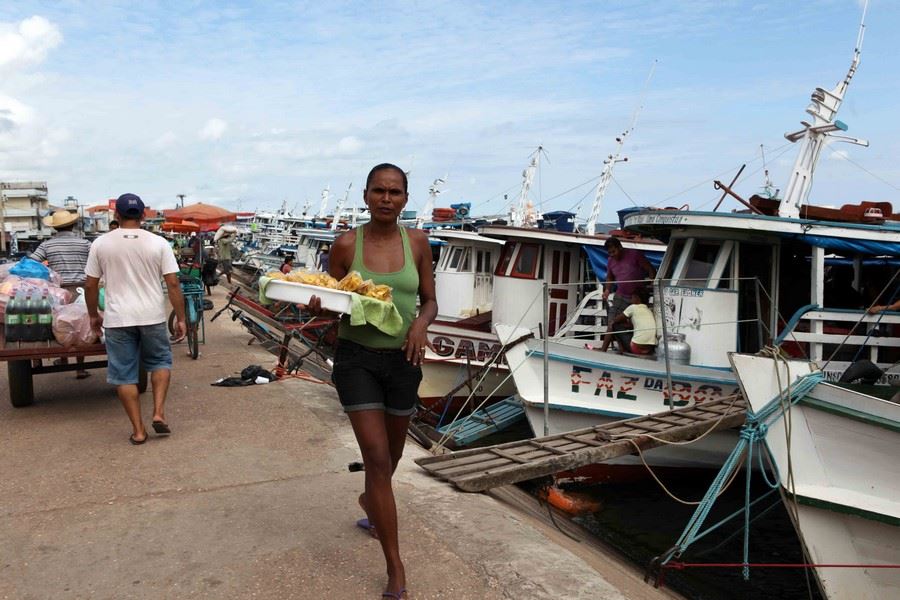 A stroll along the quays, crowded with vendors of all kinds and native porters you have to dodge, takes us to the fish market.
A stroll along the quays, crowded with vendors of all kinds and native porters you have to dodge, takes us to the fish market.
The journey begins with a visit to this small town, which had its heyday in the rubber era and is now one of the ports of shipment for soya destined for the European and Japanese markets. It is also an important port of call for the cargo ships and hammock boats that sail between Manaus and Belem.
To get from one city to another, Brazilians take three-deck boats, open to the outside world and with no cabins. Everyone hangs a hammock wherever they can and tries to kill time in a colourful and lively promiscuity.
Fish and spice market
 Some fishmongers have found the trick: they sell tourists fish that pink dolphins or botos compete with the great egrets that invite themselves to the feast.
Some fishmongers have found the trick: they sell tourists fish that pink dolphins or botos compete with the great egrets that invite themselves to the feast.
Before returning to the boat, we make a diversion to the spice market, where we can discover the medicinal preparations made from the plants of the forest. From the andiroba fruit, an excellent anti-inflammatory and insect repellent, to sucuba milk used to treat gastritis, or a kind of natural Viagra (a mixture of marapuana and guarana barks), Amazonian pharmacopoeia has solutions for every ill.
The sun begins to set as the Amazon Dream casts off and glides gently towards the famous meeting of the waters. A spectacular phenomenon due to the differences in temperature, speed and density of the water between the two rivers.
For miles, the blue waters of the Tapajos intertwine with the sediment-laden waters of the Amazon, without ever mixing. Finally, the giant Amazon engulfs the clear waters of the Tapajos in its waves.
It is one of the favourite playgrounds of the botos and grey dolphins that frolic around the ship to the delight of the passengers. Leaning against the rail, searching in vain for the shore because the river is so wide at times, we watch the many boats and rafts that criss-cross it, listening to the murmurings of the river. Here, in this aquatic tangle, the boat is king.
The Varzeá forest
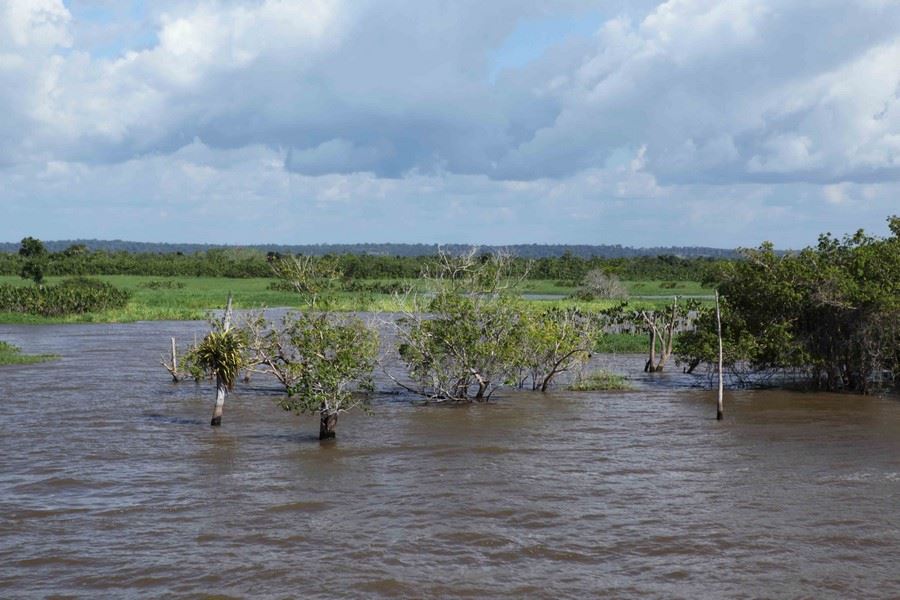 We're at the start of the dry season, but the waters are still high. This year, almost 8 metres of rain fell.
We're at the start of the dry season, but the waters are still high. This year, almost 8 metres of rain fell.
From December to June, these areas, known as Varzeá, are more or less regularly flooded, sometimes over considerable distances around the watercourses (65,000 km² and up to 80 km on either side of the river). This is a forest dominated by soft, fast-growing species, with a range of palm trees considered sacred by the Indians.
For the remaining 6 months, the Caboclos, "the people of the waters", cultivate this land rich in alluvial deposits.
 The Caboclos, descendants of Portuguese, Indian and black settlers, live on the banks of the river in houses built on stilts.
The Caboclos, descendants of Portuguese, Indian and black settlers, live on the banks of the river in houses built on stilts.
We sail down the course of the vast river, then take a branch that runs alongside Ituqui Island. After a few hours sailing, our ship will anchor for several nights at different spots in this strange landscape, which is both aquatic and terrestrial. Water is everywhere, the source of an extravagant nature with which the Caboclos live in harmony. They have learnt to live with the elements, which are not always kind, to observe nature, to feed off it and to love it.
Even ants and termites have adapted, building their nests in the forks of trees.
The journey is punctuated by meals (delicious and cooked with fresh produce) and outings ashore.
Once or twice a day, passengers are invited to board tenders to discover the flora and fauna of the floodplain forest.
A sumptuous landscape of golden lagoons, water hyacinth meadows and sand spits. One of the richest ecosystems in the world: over 60,000 varieties of plants, 2,000 species of birds and as many fish, not to mention some 400 types of mammal. You need to be attentive and silent to catch a glimpse of toucans, mangrove anises, green parrots, crested hoazins - birds with tawny plumage and red eyes rimmed with blue or a marsh kite eating a crab. While the jacanas trample the aquatic vegetation with their long slender fingers in search of insects, howler monkeys howl in the canopy. Their characteristic sonic prowess is intended for their fellow monkeys, but is enjoyed by all the inhabitants of the jungle. This doesn't seem to bother the sloths and iguanas lounging in the branches. Their cries, however, send egrets and herons flying.
 An eagle has landed on a sapucai nut.
An eagle has landed on a sapucai nut.
On the way back to the mouth of the rio Curua-Una (literally black water) and the village of Pacoval, home to a community of quilombolas (the name given to the descendants of the inhabitants of the old quilombos, communities formed by runaway slaves before the abolition of slavery in Brazil in 1887), we come across a herd of water buffalo swimming across the river. A few fishermen cast their nets from their pirogues. While in a quiet little cove, women wash themselves and their clothes.
Near the banks, you can discover the giant water lilies: Victoria amazonica, whose tray-shaped leaves can grow to 3 metres and are said to support the weight of a child.
 Near the banks, you can discover the giant water lilies: Victoria amazonica, whose tray-shaped leaves can grow to 3 metres and are said to support the weight of a child.
Near the banks, you can discover the giant water lilies: Victoria amazonica, whose tray-shaped leaves can grow to 3 metres and are said to support the weight of a child.
Maguari and the primary forest
During the cruise, several walks are organised to discover the primary forest, where man has never intervened. The most notable is the excursion into the secondary forest (which was once exploited and then returned to a wild state) and then the primary forest in the Tapajoara extractivist reserve, which covers 600,000 hectares. This is a 6-hour walk supervised by native guides from the village of Maguari, a community on the shores of the Tapajos National Forest, who will show us some of the secrets of this green ocean.
The lushness and exuberance of the Amazon rainforest are often the words most often used to describe it. A prolific belly that is thought to be inexhaustible. But it is also a fragile universe where the balance is precarious, with natural riches that whet the appetite of multinationals and human beings alike. The damage caused to the forest is extensive, and began with the opening up of the Amazon by road. Day by day, the damage is increasing and intensifying. Deforestation is steadily increasing, in particular to plant soya, which is ruining the soil in twenty years or so.
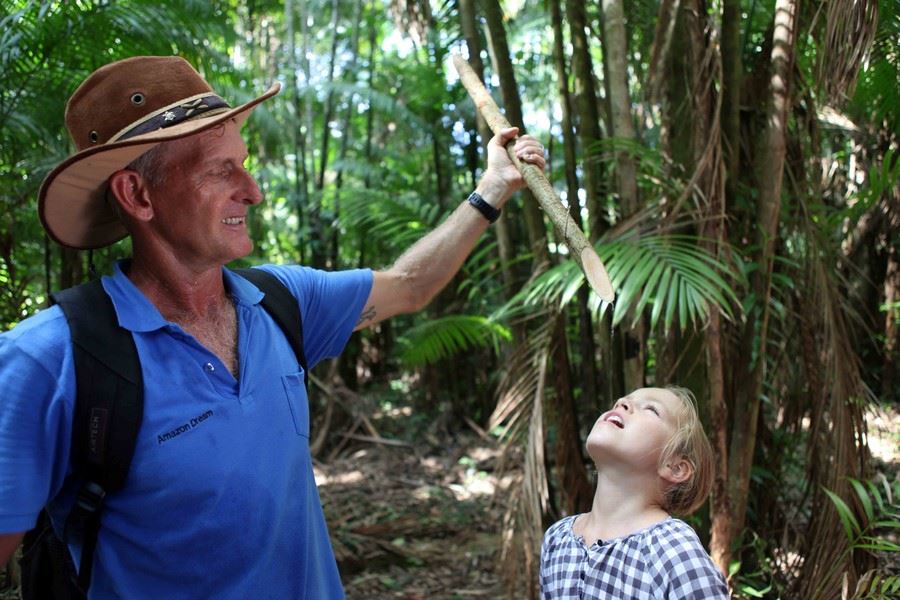 The imbauba root is full of water and is a great thirst-quencher.
The imbauba root is full of water and is a great thirst-quencher.
Machetes in hand, our guides lead the way. Progress is slow in the tropical heat and humidity. The instructions are not to stray from the path. And not to touch any of the beautiful, brightly-coloured little frogs you might come across, as they are poisonous. Nor the spiders, some of which are extremely painful to bite. Beneath the foliage, the primary forest sounds of a thousand spirits. Occasionally, the call of a monkey can be heard from the canopy, but they are fearful and flee at our approach.
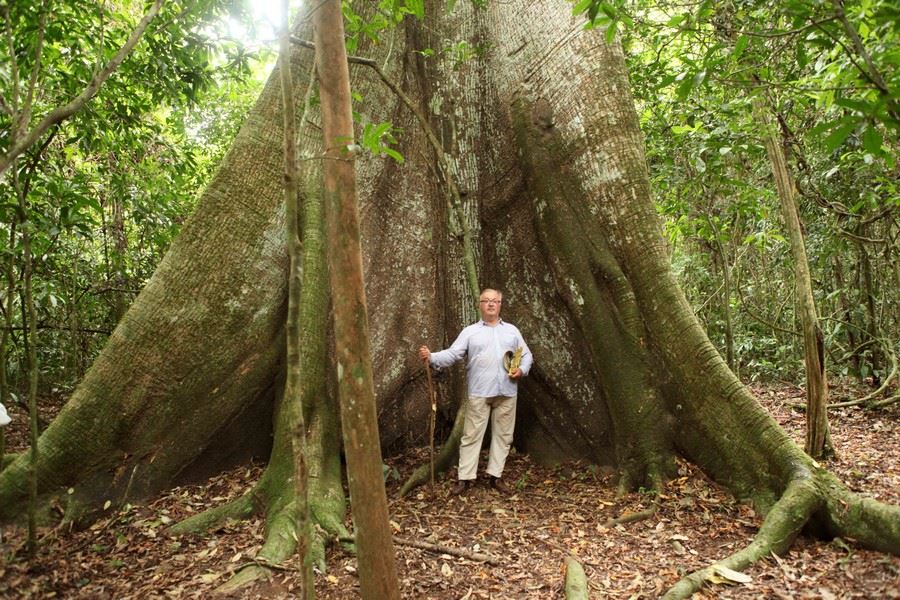 The walk takes us past huge trees ranging in age from 600 to over 1,000 years.
The walk takes us past huge trees ranging in age from 600 to over 1,000 years.
From these natural organs hang creepers that serve as swings for the children in the group.
Some of the trunks stand out in admiration: Cassia alata (at the foot of which you can find their yellow flowers), ficus, itauba, Brazilian walnut trees, imbauba whose roots provide water when cut. In the canopy, the crowns of the trees blend together very little. It's as if these majestic creatures avoid touching each other, a phenomenon that scientists find hard to explain and which they call "tree shyness".
Sapucai flower.
In this immense hanging garden, the trees offer their flowers, invisible from the ground, to a huge variety of pollinators. Here and there, a bright red passion flower stands out. Insects can't miss it. On the other hand, the morphos, the large metallic blue butterflies, although easy to spot, are impossible to follow, let alone photograph, as they are so fast. After paying a visit to the "grandmother of the forest", its oldest tree, we return to the Amazon Dream, which resumes its journey on the Tapajos towards the Mundurucus village.
Ritual among the Mundurucus
Little Mundurucus girl dressed for the ritual.
In the evening, in the village of Bragança, we will attend a ritual of thanksgiving to 'Mother Nature' for her benefits and generosity. A beautiful moment of authenticity and sharing. At dusk, our Mundurucus hosts come to fetch us in a dug-out canoe, in silence, as if to better immerse us in the forest that surrounds us. This Amazonian ethnic group was once a bellicose nation, raiding other territories for trophies of enemy heads. Today, they are hunters, fishermen and farmers, fighting for their survival while remaining attached to their ancestral rites. They still paint turtle scales on their bodies, a cunning and determined animal that can defeat tapirs, jaguars and anacondas, before performing their ritual invocation of the mother of the forest to obtain her permission to go hunting, to be lucky and to bring back good catches.
The art of slow travel
Excursions into the forest or small villages and outings in dinghies or dugout canoes alternate with peaceful hours of sailing, which everyone can enjoy in their own way.
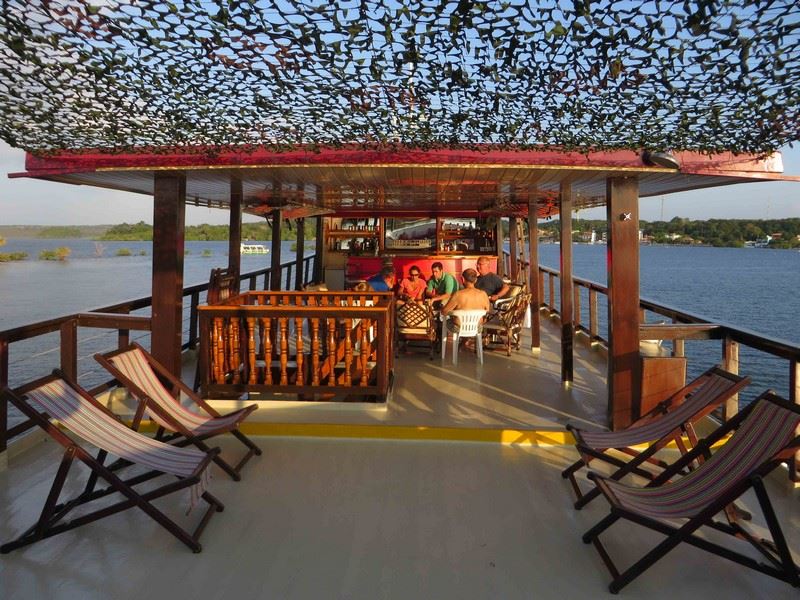 The programme includes lounging on the bar deck, siestas in the air-conditioned cabins and discussions between passengers over a caipirinha (a delicious Brazilian cocktail made from cachaça and lime) or local fruit juice.
The programme includes lounging on the bar deck, siestas in the air-conditioned cabins and discussions between passengers over a caipirinha (a delicious Brazilian cocktail made from cachaça and lime) or local fruit juice.
Not forgetting the piranha fishing or the almost daily swimming breaks in the blue waters of the Tapajos. No one can resist it!
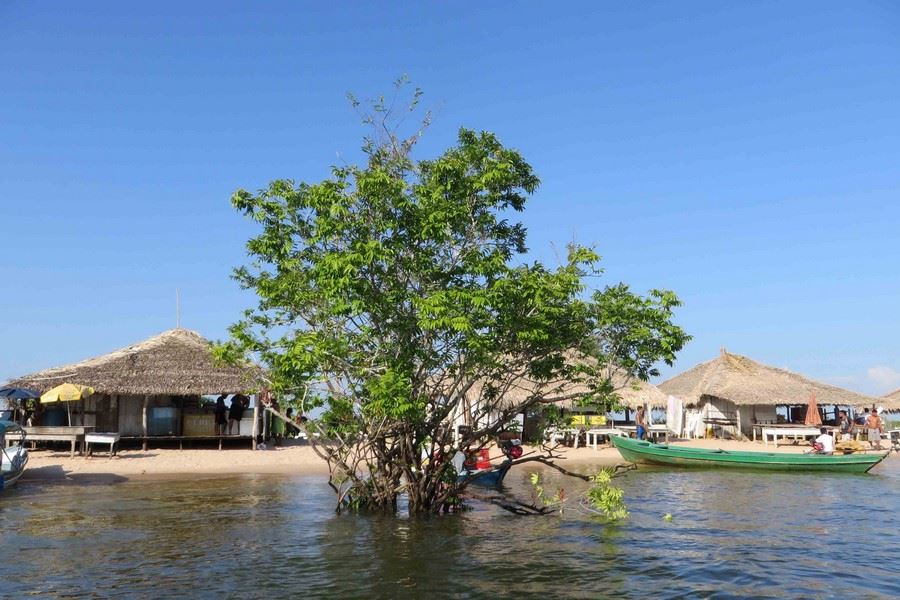 The sparkling white sandy beaches are worthy of the Caribbean, and often just for us.
The sparkling white sandy beaches are worthy of the Caribbean, and often just for us.
At dusk, when the skies turn pink and purple, the breeze carries the scent of ipe and preciosa. As night falls, the tops of the trees are outlined in the pale moonlight, the surface of the water, now black, sparkles under the stars and we can admire the Southern Cross, the symbol found on the Brazilian flag. It makes you imagine Francisco de Orellana, who was the first to sail down the Amazon in 1542. Setting out from the banks of the Napo in Ecuador, he was harassed by hostile tribes and, in spite of himself, allowed himself to be dragged all the way to Belèm, where he landed after several months of sailing, recounting epic battles against formidable female warriors. In fact, they were Indians from the Tapuya tribe, in which the women were apparently not reduced to domestic chores but fought naked alongside the men. Orellana thought he saw the Amazons of Greek mythology, and so he named the river.
The boat and its crew
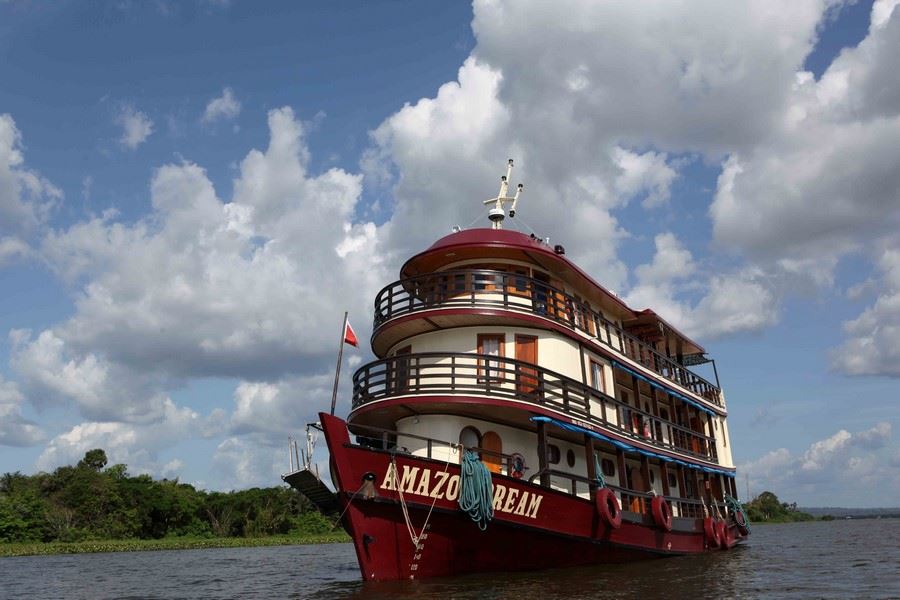
At 27.50 metres long, the Amazon Dream is a ship of traditional design, built from Ipe and Itauba wood. It left the shipyard in 2007. Its cruising speed is 11-12 knots (20-22 km/h). Its 380 hp Scania engine makes a speed of 12 knots. G.P.S., sonar, compass, radio and echo sounder complete the equipment in the wheelhouse. The captain and his first mate, the mechanic, the barman and his assistant, the cook, 2 chambermaids, a guide and a young Franco-Brazilian trainee who assists him make up the crew.
The boat offers 9 very comfortable cabins (air-conditioned, private bathroom) and can accommodate 18 passengers in remarkable conditions of welcome, service and safety. A team of enthusiasts will share with you their knowledge of the fauna, flora and peoples of the Amazon rainforest.
Getting there : https://www.fleuves-du-monde.com/voyage-amazone/amazon-dream
Text and Photos : Brigitte Postel



